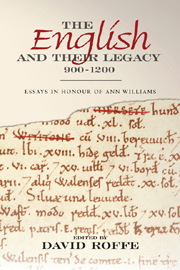Book contents
- Frontmatter
- Contents
- Figures and Tables
- Dedication
- Preface
- Contributors
- Abbreviations
- Ann Williams: a Personal Appreciation
- Life-writing and the Anglo-Saxons
- Meet the Swarts: Tracing a Thegnly Family in Late Anglo-Saxon England
- The Moneyers of Kent in the Long Eleventh Century
- Master Wace: a cross-Channel Prosopographer for the Twelfth Century?
- From Minster to Manor: the Early History of Bredon
- Eadulfingtun, Edmonton, and their Contexts
- The Family of Wulfric Spott: an Anglo-Saxon Mercian Marcher Dynasty?
- The Burial of King Æthelred the Unready at St Paul's
- Eustace II of Boulogne, the Crises of 1051–2 and the English Coinage
- Through the Eye of the Needle: Stigand, the Bayeux Tapestry and the Beginnings of the Historia Anglorum
- Robert of Torigni and the Historia Anglorum
- Invoking Earl Waltheof
- Hidden Lives: English Lords in post-Conquest Lincolnshire and Beyond
- Lordship and Lunching: Interpretations of Eating and Food in the Anglo-Norman World, 1050–1200, with Reference to the Bayeux Tapestry
- The Exchequer Cloth, c. 1176–1832: the Calculator, the Game of Chess, and the Process of Photozincography
- Ann Williams: a Bibliography 1969–2011
- Index
- Tabula Gratuloria
The Burial of King Æthelred the Unready at St Paul's
Published online by Cambridge University Press: 05 April 2013
- Frontmatter
- Contents
- Figures and Tables
- Dedication
- Preface
- Contributors
- Abbreviations
- Ann Williams: a Personal Appreciation
- Life-writing and the Anglo-Saxons
- Meet the Swarts: Tracing a Thegnly Family in Late Anglo-Saxon England
- The Moneyers of Kent in the Long Eleventh Century
- Master Wace: a cross-Channel Prosopographer for the Twelfth Century?
- From Minster to Manor: the Early History of Bredon
- Eadulfingtun, Edmonton, and their Contexts
- The Family of Wulfric Spott: an Anglo-Saxon Mercian Marcher Dynasty?
- The Burial of King Æthelred the Unready at St Paul's
- Eustace II of Boulogne, the Crises of 1051–2 and the English Coinage
- Through the Eye of the Needle: Stigand, the Bayeux Tapestry and the Beginnings of the Historia Anglorum
- Robert of Torigni and the Historia Anglorum
- Invoking Earl Waltheof
- Hidden Lives: English Lords in post-Conquest Lincolnshire and Beyond
- Lordship and Lunching: Interpretations of Eating and Food in the Anglo-Norman World, 1050–1200, with Reference to the Bayeux Tapestry
- The Exchequer Cloth, c. 1176–1832: the Calculator, the Game of Chess, and the Process of Photozincography
- Ann Williams: a Bibliography 1969–2011
- Index
- Tabula Gratuloria
Summary
In the late summer of 1015 Cnut, brother of Harold, king of the Danes, brought a fleet to Sandwich, in north-eastern Kent, and set out from there on the campaign which had led by the close of the following year to his accession as king of the whole of England. In the midst of the Danish invasion, and after a reign of over 38 years, Æthelred, king of the English, died at London on St George's Day (23 April) 1016. The notice of Æthelred's death in the Anglo-Saxon Chronicle adds that ‘he had held his kingdom with great toil and difficulties as long as his life lasted’; and we learn from later sources that Æthelred was buried with all due honour in the church of St Paul. A modern visitor to St Paul's Cathedral is unlikely to have gone there in search of the tomb of King Æthelred the Unready, and, if he had, would not find it. The tomb was lost when the medieval cathedral was destroyed in the Great Fire of London in 1666, though Æthelred's name is to be found on a modern inscribed stone, set up on a wall of the café in the crypt, which replaces all the memorials known to have been lost in the conflagration. It is more likely, therefore, that a modern visitor would go to St Paul's for Nelson and Wellington, or for the granite slab marking the tomb of Sir Christopher Wren, beneath its famous inscription: ‘Lector, si monumentum requiris, circumspice’.
- Type
- Chapter
- Information
- The English and their Legacy, 900–1200Essays in Honour of Ann Williams, pp. 129 - 148Publisher: Boydell & BrewerPrint publication year: 2012



